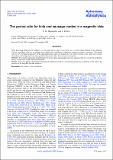Files in this item
The period ratio for kink and sausage modes in a magnetic slab
Item metadata
| dc.contributor.author | Macnamara, C. K. | |
| dc.contributor.author | Roberts, B. | |
| dc.date.accessioned | 2014-01-14T13:01:02Z | |
| dc.date.available | 2014-01-14T13:01:02Z | |
| dc.date.issued | 2011-02 | |
| dc.identifier | 6037629 | |
| dc.identifier | 0b36d3c8-debc-4c96-aad5-d078061980d9 | |
| dc.identifier | 000286458400087 | |
| dc.identifier | 78650911640 | |
| dc.identifier.citation | Macnamara , C K & Roberts , B 2011 , ' The period ratio for kink and sausage modes in a magnetic slab ' , Astronomy & Astrophysics , vol. 526 , A75 . https://doi.org/10.1051/0004-6361/201015460 | en |
| dc.identifier.issn | 0004-6361 | |
| dc.identifier.other | ORCID: /0000-0003-4961-6052/work/27162490 | |
| dc.identifier.uri | https://hdl.handle.net/10023/4366 | |
| dc.description | A75 article number | en |
| dc.description.abstract | Aims. Increasing observational evidence of wave modes in the solar corona brings us to a closer understanding of that medium. Coronal seismology allows us to combine wave observations and theory to determine otherwise unknown parameters. The period ratio, P-1/2P(2), between the period P-1 of the fundamental mode and twice the period P-2 of its first overtone, is one such tool of coronal seismology and its departure from unity provides information about the structure of the corona. Methods. We consider analytically the period ratio for the fast kink and sausage modes of a magnetic slab, discussing both an Epstein density profile and a simple step function profile. Results. Transverse density structuring in the form of an Epstein profile or a step function profile may contribute to the shift of the period ratio for long thin slab-like structures. | |
| dc.format.extent | 7 | |
| dc.format.extent | 651956 | |
| dc.language.iso | eng | |
| dc.relation.ispartof | Astronomy & Astrophysics | en |
| dc.subject | Corona | en |
| dc.subject | Oscillations | en |
| dc.subject | Coronal seismology | en |
| dc.subject | Epstein density profile | en |
| dc.title | The period ratio for kink and sausage modes in a magnetic slab | en |
| dc.type | Journal article | en |
| dc.contributor.institution | University of St Andrews. Applied Mathematics | en |
| dc.identifier.doi | 10.1051/0004-6361/201015460 | |
| dc.description.status | Peer reviewed | en |
This item appears in the following Collection(s)
Items in the St Andrews Research Repository are protected by copyright, with all rights reserved, unless otherwise indicated.

